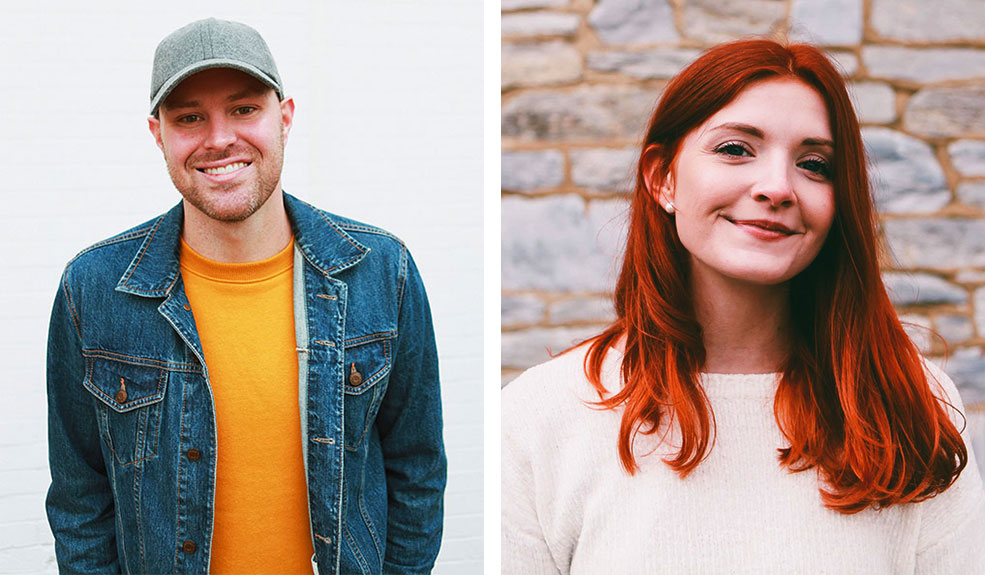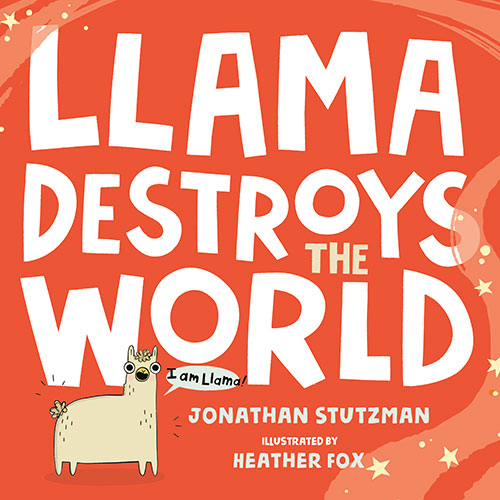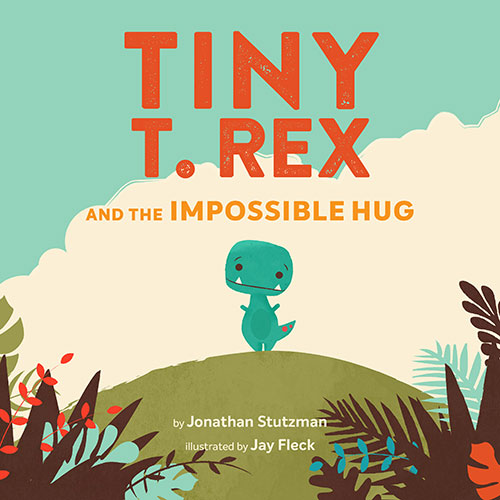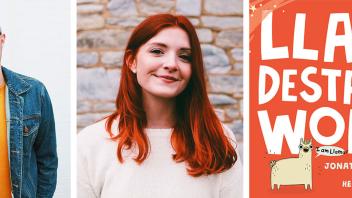Humor is very subjective and I know that I’m a tough critic. Recently, however, I shared a book with my 5-year old niece and I could barely contain my own giggles. But it was her “ooohs” and laughter that made me giggle even more. But no one enjoyed the book more than my sister who now wants her own copy.
I decided I had to find out more about who created Llama Destroys the World (Holt), a husband–wife creative team.
Happily, author Jonathan Stutzman and Llama’s illustrator, Heather Fox, agreed to do an interview.

You’re both relatively new to the children’s book world. Why did you decide to write for young readers?
Jonathan: We’ve both been drawn to children’s stories most of our lives. I’ve had a passion for comics (Peanuts, Calvin & Hobbes, Garfield) from an early age and I started creating my own around age 8 or 9. I wrote my first storybook at 11.
Heather: And I’ve been drawing forever, I made my first picture book at age 7. It was about Aliens invading a K-Mart!
Jonathan: We met and started dating while Heather was still in college studying illustration.
Heather: I was taking a course where we had to take an old folktale, illustrate it, and make it into a picture book. I asked Jonathan to rewrite it and when it was done, we decided to self-publish it.
Jonathan: We had a blast doing it! We were researching, taking out stacks of books from the library, hanging out in bookstores and reading all the books we could find — we were instantly taken by how many amazing picture books were out there, and how FUN they were to make. We fell in love with picture books, and better, we fell in love with each other too.
Where did this story come from?

Jonathan: We really wanted to make this big, wacky story that was fun and weird, that both children and the parents reading it could giggle along with and just let go and have fun. I think humor is really important for kids (and adults too). Being silly and zany, it’s one of the ways we find joy and express ourselves, especially when the pressures and darkness of life creeps in.
Heather: Jonathan came up with the title first. It was fun and silly! And then I went and drew the character, which inspired him to dive into the story and create all the events that led this naive llama to destroy the world.
Jonathan: We work that way often. I will come up with ideas or stories, and send it Heather’s way. She will mock up some character designs, and seeing the character or the world come to life in art will inspire me for the rest of the book.
For Llama, we wanted to play off the juxtaposition of this omniscient dramatic narrator and this happy go-lucky (hungry!) Llama who doesn’t know the destruction he is causing.
I love food. And I’ve always loved characters in books that ate a lot (I have no idea why), Benny from the Boxcar Children and Chet Morton from the Hardy Boys and of course, Garfield the cat. The image of animated characters eating a whole sandwich or stack of flapjacks in one gulp was always something that fascinated me as a kid. So I pulled from those characters to create Llama.
How did you achieve the jaunty textual and visual pacing in this book?
Jonathan: Pacing is one of the most important parts of storytelling, and it’s essential for picture books. I’m still trying to learn how to get better at it. Reading a picture book is all about the flow of the page (image and text) and the page turns.
We structured the book with the days of the week, to set up a “doomsday countdown” to add a dramatic flow to the story, hopefully building on each day, and for the kids who know the order of the days of the week, building to the final destruction of the world. This also works really well for read-alouds, having the children repeat each day dramatically after the reader. It’s been really fun to see them get into it, especially for “FRIDAY!!!!”.
Heather: Visually, we focus on Llama and his actions for most of the book … until the doom of the world was imminent. In the final sequence of destruction, in order to show the epicness of the destruction, I used a lot of wider full-spread illustrations to show the end of the world with more detail, scope, and scale.
The humor is over-the-top and very kid-friendly. How do you convey humor in text? In image? How do they come together?
Jonathan: Humor can be difficult because everyone has different types of humor they enjoy. There is a lot of absurd humor in the book, which works as being both playful and dramatic. I think the dance between the faux seriousness of the words and silliness of the art is so so fun, and always has wonderful humorous potential for kids. Especially on the second read through. I’ve seen in readings that not every kid will get all the humor on the first reading.
The drama of the world being destroyed (and the black hole) is what grabs their attention — the tension in the buildup. And it isn’t until a second reading (and then on to third and fourth), when they are in on the joke now, they laugh and giggle and appreciate all the silliness more. And for all the over-the-top absurdity of the story, we tried to ground the character in relatable (and human) situations.
Llama is like us. Llama eats too much (I’ve definitely done that). Llama dances silly dances (I do that all the time)! Llama rips his pants (yep, me X 3). Llama is oblivious to things going on around him because he is busy creating (so uh … maybe I am Llama?). Children defiantly gravitate to him the most, which is also a testament to how expressive Heather made the character visually. They also love the phrase “DAT!”
Heather: As Jonathan mentioned, we wanted the text and art to play off each other to create the humor. When his words were dramatic … my art became sillier. My focus was on the character of Llama, making him expressive and relatable and of course, silly. He is naive, joyful, and confident, and … a little bit self-centered. He doesn’t mean to create the end of the world, nor does he actually realize he does indeed do that.
This is your first picture book collaboration, isn’t it? What is your process? Which comes first, word or image?
Heather: In the case of Llama, the title came first, then an image of what he might look like, and then the story. It varies from book to book, but we really like to bounce titles off each other and give a synopsis what might happen within the story.
Heather, the illustrations in Llama … were created digitally. What is the process? Do you work in other mediums? How does illustration create character?
Heather: Yes! All of the illustrations were created digitally, though I usually like to begin projects by sketching things out the good old-fashioned way. I work primarily within an app on my iPad called “ProCreate,” so it’s really easy for me to simply photograph my sketches and import them into my workspace documents. I feel most comfortable working digitally because it seems to give me the most creative freedom- it’s so easy to make changes, switch up layouts, and just experiment and have fun.
With creating Llama, though he did develop visually as the book developed, the big thing that stayed consistent was his expressiveness. Llama has these big eyes that I can capture so many little nuances with and it’s such a big part of his character. You’ll probably notice that in some of my other work too- eyes are the starring character of the face!
What distinguishes a picture book? (In other words, what is it that makes picture books special?)
Jonathan: For me it is the way picture books are read. It’s a shared experience between the reader and the child. Picture books aren’t just about the words authors write or the pictures illustrators make, it’s about the reading experience and all the personal additions: the drama in the readers voice, the silly voices they make for the characters, the responses of the child/children on their second-third-fourth-hundreth read-through when they know the story and characters, and of course, the dramatic pause and reveal from the turning of pages. It’s very collaborative and personal, and unlike any other form of story out there.
Will Llama ever star in another book?
Heather: Yes! Next year Llama will star in the sequel titled Llama Unleashes the Apocalypse. Llama makes a mess of his home, invites his tidy friend Alpaca over, and proceeds to invite Alpaca into his newly constructed cloning device. More messes are made in the process and Llama is faced with even more problems.
What’s next for you either together or as individuals?

Jonathan: Heather and I have lots of books on the way (I will let her tell you about them)! Also, I have a picture book series with illustrator Jay Fleck and Chronicle books, the first book is out now: Tiny T. Rex and the Impossible Hug (Chronicle), the sequel Tiny T. Rex and the Very Dark Dark comes out in spring 2020.
And a lyrical picture book with Joseph Kuefler titled Night Is for Darkness coming out with HarperCollins, about the magic of nighttime.

Heather: So far in my career, all of my books are in collaboration with Jonathan. We have four books coming out in 2020, including the aforementioned Llama sequel, and a silly picture book called Butts Are Everywhere.
Our next book releases in February and is another silly cause-effect picture book titled Don’t Feed the Coos (Holt). It follows a little girl who is warned not to feed the coo (our word for “pigeon”), but she does it anyway which sets off a chain of chaotic events!
Jonathan: And then to end the year we have a funny Christmas picture book called Santa Baby, in which Santa, feeling old, makes a wish to be young again and accidentally turns himself into a baby. We have more down the road too, including a young reader graphic novel series, and lots more we are working on. We feel really blessed to be able to make books! It is a dream come true. We have so much fun doing it and we hope kids and parents have even more fun reading them!
And fun it is when you read and share books by this dynamic duo! Everyone — young and old — could all use a good laugh and Llama is just right to start it.
Many thanks to Jonathan and Heather! I think we’ll look forward to their forthcoming books and the laughter that is sure to go along with them.
About the Author
Reading Rockets’ children’s literature expert, Maria Salvadore, brings you into her world as she explores the best ways to use kids’ books both inside — and outside — of the classroom.

